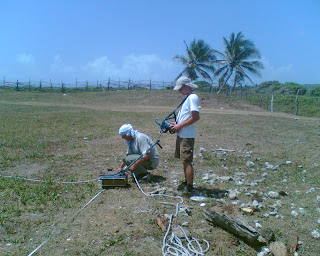Living in another culture means you have to change your strategies. In the Netherlands or Britain one waits at a busstop, in a queue if necessary, stamps a ticket and sits down until the required stop. In the Dominican Republic, you ARE the busstop. It’s best to avoid puddles and sharp bends when picking your spot, but anywhere suffices. Once you have flagged the bus (or guagua) down, and no matter how many people are already on the bus, or falling out of the door, you squeeze on, resolutely. There’s no point gingerly choosing the best seat (out of the sun, or away from the man with the chickens on his lap), because there won’t be one, and if there is, someone will soon be cuddling up to you and placing their bags and boxes on you. There is no private space on a Dominican guagua. The best thing to do is sit back (although careful if you have your back crouched against the open door), enjoy the merengue on the radio and buy some sugar cane, empanadas or dulce de leche, shoved through the window at you at regular intervals from a streetseller outside. Buses are generally extremely hot, sticky to the touch and have the motion of a boat on a choppy sea. On the outside they always have some cheery evangelical sticker pronouncing: “Con Dios y el camino”, or “Dios me protege” (which given the number of deaths on the road and guagua crashes is clearly too difficult, even for god).
In the Dominican Republic, you ARE the busstop. It’s best to avoid puddles and sharp bends when picking your spot, but anywhere suffices. Once you have flagged the bus (or guagua) down, and no matter how many people are already on the bus, or falling out of the door, you squeeze on, resolutely. There’s no point gingerly choosing the best seat (out of the sun, or away from the man with the chickens on his lap), because there won’t be one, and if there is, someone will soon be cuddling up to you and placing their bags and boxes on you. There is no private space on a Dominican guagua. The best thing to do is sit back (although careful if you have your back crouched against the open door), enjoy the merengue on the radio and buy some sugar cane, empanadas or dulce de leche, shoved through the window at you at regular intervals from a streetseller outside. Buses are generally extremely hot, sticky to the touch and have the motion of a boat on a choppy sea. On the outside they always have some cheery evangelical sticker pronouncing: “Con Dios y el camino”, or “Dios me protege” (which given the number of deaths on the road and guagua crashes is clearly too difficult, even for god).
Paying is another matter. The cobrador (conductor) has what seems like an extremely stressful job to me, but one which they enjoy immensely as it means chatting and socializing up and down the road all day. There must be a system, but I don’t know what it is. At a certain point in the journey, the cobrador moves off the step in the open door, and either by stretching over people’s heads (there is never room in the aisle), or by sidestepping along the bumper along the outside of the bus whilst in motion and poking his head through each window, he collects the fares. The trick is to save all your small change for the bus, otherwise you risk getting back enough greasy notes to paper a bathroom in the former DDR. No one ever has the right change here, so it can be kilometers before you get the right money back, but nevertheless, you do.
It’s no easy feat to get off either, unless you overcome European timidity of drawing attention to yourself in public. But unless you shout “dejame aqui!” in a loud enough voice to beat the radio and the other 50 passengers, it won’t stop.
There is another type of bus here, a bigger one which covers longer journeys and for a few extra pesos you get a numbered seat and the luxury of a DVD. The DVD on the last bus I was on back from Santo Domingo to Higuey was Anthony Santos in concert, a famous bachatero. I was pleased about this as one of my ambitions is to go to a live bachata concert. After the DVD however I had second thoughts. Anthony, who sings such classics as “Llora” and “Anoche sone con ella”, spent the whole concert strutting up and down waving the Dominican flag, kissing women and making them dance humiliating dances in front of him on the stage (“El caballo: quattro patas en la tierra” etc.)…actually, it looked great fun!
A busride here always leave me with a sense of wellbeing and confirms my faith in human nature. You always get chatted to, no matter how rubbish your Spanish (and not always by men), you always get good advice about where and when to change, you need never fear about doing the wrong thing. A ride on a guagua is like a concentration of the Dominican experience which displays the way they do things, in what Benitez Rojo would call “de cierta manera”.
 In the
In the 










